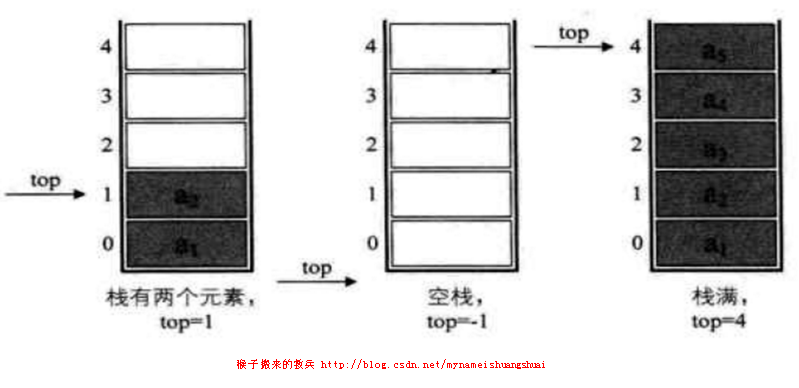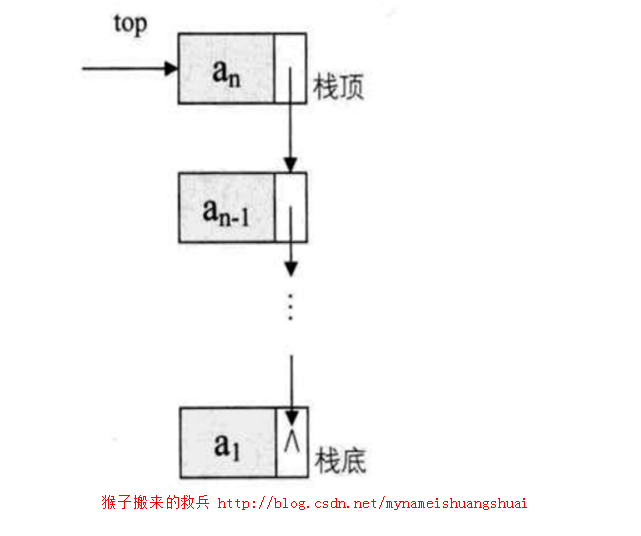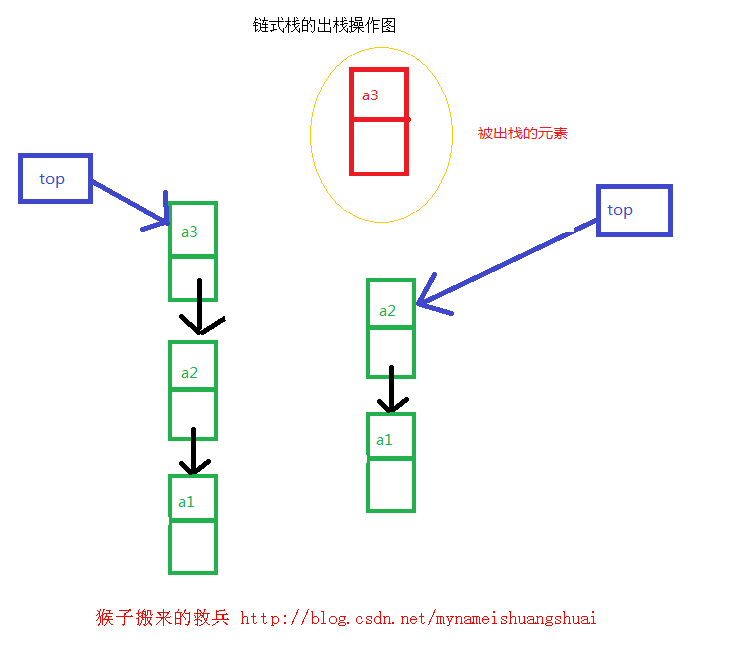线性表数据结构解读(三)栈结构Stack
2016-09-28 13:32
267 查看
在上一篇文章中,我们详细介绍了链式存储结构,并结合LinkedList源码进行了分析,相关文章大家可以点击这里回看我的博客:线性表数据结构解读(二)链式存储结构LinkedList

将栈在顺序存储结构下所得到的结构成为顺序栈。顺序栈类类似于数组,因此可以使用数组实现顺序栈的相关运算,通常栈底是下标为0的一端。

● 链式栈
将栈在链式存储结构下所得到的结构,称为链式栈。链式栈类似于指针,在java中可以通过类的对象引用实现指针运算。



在Android中,我们常见具有代表性的栈结构为Stack,下面我们进行分析,看看它内部是如何实现入栈和出栈操作的。
我们注意到源码中push方法中用到了父类的addElement(),这里我们去Stack的父类Vector中一探究竟。
参考来源:动脑学院Danny老师数据结构课程
栈的定义
栈是一种特殊的线性表,其全部操作都被限制在表的固定一端进行,而且构成栈的元素必须是同一数据类型。栈的特点
允许插入和删除的一端称为栈顶(top),另一端称为栈底(bottom),不含任何数据元素的栈称为空栈。栈又称为后进先出的线性表栈的操作
栈的常用操作包括建立栈、元素入栈、元素出栈、取栈顶元素等。空栈
当建立一个栈时,不包括任何元素,此时称其为空栈。栈为空时top和bottom共同指向栈底。向栈中插入元素成为入栈,使top指向的元素退出栈,称为出栈,出栈和入栈操作全部是针对栈顶元素进行操作的。
栈的存储结构
● 顺序栈将栈在顺序存储结构下所得到的结构成为顺序栈。顺序栈类类似于数组,因此可以使用数组实现顺序栈的相关运算,通常栈底是下标为0的一端。

● 链式栈
将栈在链式存储结构下所得到的结构,称为链式栈。链式栈类似于指针,在java中可以通过类的对象引用实现指针运算。

链式栈的入栈操作
把top的引用指向新的结点,新结点的下一个引用指向原来的top结点
链式栈的出栈操作
把top的引用指向原栈顶元素的下一个元素,并释放原栈顶元素的引用
栈结构在Android中的应用
可以参考我的博客:彻底弄懂Activity四大启动模式在Android中,我们常见具有代表性的栈结构为Stack,下面我们进行分析,看看它内部是如何实现入栈和出栈操作的。
public class Stack<E> extends Vector<E> {
private static final long serialVersionUID = 1224463164541339165L;
/**
* 无参构造方法
*/
public Stack() {
}
/**
* 判断是否为空
* Returns whether the stack is empty or not.
* @return {@code true} if the stack is empty, {@code false} otherwise.
*/
public boolean empty() {
return isEmpty();
}
/**
* 返回栈顶的元素
* Returns the element at the top of the stack without removing it.
* @return the element at the top of the stack.
* @throws EmptyStackException if the stack is empty.
* @see #pop
*/
@SuppressWarnings("unchecked")
public synchronized E peek() {
try {
return (E) elementData[elementCount - 1];
} catch (IndexOutOfBoundsException e) {
throw new EmptyStackException();
}
}
/**
* 弹出栈
* Returns the element at the top of the stack and removes it.
* @return the element at the top of the stack.
* @throws EmptyStackException if the stack is empty.
* @see #peek
* @see #push
*/
@SuppressWarnings("unchecked")
public synchronized E pop() {
if (elementCount == 0) {// 如果为0则为空栈
throw new EmptyStackException();// 抛出空栈异常
}
// index是被弹出栈元素的下标(先减再赋值)
final int index = --elementCount;
final E obj = (E) elementData[index];
elementData[index] = null;// 把弹出栈的元素值设为空
modCount++;
return obj;
}
/**
* 推入栈操作
* Pushes the specified object onto the top of the stack.
* @param object The object to be added on top of the stack.
* @return the object argument.
* @see #peek
* @see #pop
*/
public E push(E object) {
// 添加一个元素
addElement(object);
return object;
}
/**
* 查询操作,该方法一定要是线程安全的,不能一边遍历一边增删
* Returns the index of the first occurrence of the object, starting from
* the top of the stack.
* @return the index of the first occurrence of the object, assuming that
* the topmost object on the stack has a distance of one.
* @param o the object to be searched.
*/
public synchronized int search(Object o) {
final Object[] dumpArray = elementData;
// 非空栈元素的数量
final int size = elementCount;
if (o != null) {// 如果传进来的元素不等于空
for (int i = size - 1; i >= 0; i--) {// 从栈顶遍历下去
if (o.equals(dumpArray[i])) {//如果传进来的元素等于dumpArray[i]
return size - i;
}
}
} else {
for (int i = size - 1; i >= 0; i--) {
if (dumpArray[i] == null) {// 如果dumpArray[i]等于null
return size - i;
}
}
}
return -1;
}
}我们注意到源码中push方法中用到了父类的addElement(),这里我们去Stack的父类Vector中一探究竟。
addElement方法
/**
* 添加元素方法
* Adds the specified object at the end of this vector.
* @param object the object to add to the vector.
*/
public synchronized void addElement(E object) {
// 容量长度和非空元素数量相同
if (elementCount == elementData.length) {
growByOne();
}
elementData[elementCount++] = object;
modCount++;
}growByOne方法
/**
* JIT optimization
*/
private void growByOne() {
int adding = 0;
if (capacityIncrement <= 0) {
// 判断是否是空栈,如果为空增加1
if ((adding = elementData.length) == 0) {
adding = 1;
}
} else {// 否则扩容capacityIncrement
adding = capacityIncrement;
}
// 新创建一个数组,把数组长度扩容,然后数组复制
E[] newData = newElementArray(elementData.length + adding);
System.arraycopy(elementData, 0, newData, 0, elementCount);
elementData = newData;
}参考来源:动脑学院Danny老师数据结构课程
相关文章推荐
- 线性表数据结构解读(三)栈结构Stack
- 线性表数据结构解读(一)顺序存储结构ArrayList
- 线性表数据结构解读(六)链式哈希表结构-LinkedHashMap
- 线性表数据结构解读(二)链式存储结构LinkedList
- 数据结构之线性结构(stack、queue、linklist)概念
- 线性表数据结构解读(五)哈希表结构-HashMap
- 线性表数据结构解读(二)链式存储结构LinkedList
- 线性表数据结构解读(四)队列结构Queue
- 数据结构之线性表
- C#数据结构(一)----线性表
- 数据结构笔记3 线性表的链式表示
- 数据结构之线性结构(二,联合数组等)
- 数据结构之应用 "栈(Stack)" 实现: 解析算术表达式及计算求值 (C#/Java)
- 数据结构线性表的ADT
- 数据结构之线性结构(顺序表)【一】
- 数据结构之应用 "栈(Stack)" 实现: 解析算术表达式及计算求值 (C#/Java)
- 【数据结构与算法基础】栈及其应用后缀、中缀表达式 / Stack and postfix/infix expression
- 数据结构—线性表的链式表示和实现
- 数据结构之线性表顺序存储的常用操作(转载)
- C#数据结构之线性表
